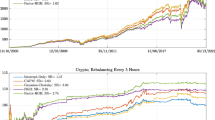Abstract
Multifactor models can be used to predict returns, generate estimates of abnormal return, and estimate the variability and covariability of returns. This chapter focuses on the use of multifactor models to describe the covariance structure of returns1. Asset return covariance matrices are key inputs to portfolio optimization routines used for asset allocation and active asset management. A factor model decomposes an asset’s return into factors common to all assets and an asset specific factor. Often the common factors are interpreted as capturing fundamental risk components, and the factor model isolates an asset’s sensitivities to these risk factors. The three main types of multifactor models for asset returns are: (1) macroeconomic factor models; (2) fundamental factor models; and (3) statistical factor models. Macroeconomic factor models use observable economic time series like interest rates and inflation as measures of pervasive or common factors in asset returns. Fundamental factor models use observable firm or asset specific attributes such as firm size, dividend yield, and industry classification to determine common factors in asset returns. Statistical factor models treat the common factors as unobservable or latent factors. Estimation of multifactor models is type-specific, and this chapter summarizes the econometric issues associated with estimating each type of factor model and gives illustrations using S-PLUS.
A recent review of factor models for this purpose is given in Chan, Karceski and Lakonishok (1998).
Access this chapter
Tax calculation will be finalised at checkout
Purchases are for personal use only
Preview
Unable to display preview. Download preview PDF.
Similar content being viewed by others
15.6 References
Alexander, C. (2001). Market Models: A Guide to Financial Data Analysis, John Wiley & Sons, Chichester, UK.
Bai, J. and Ng, S., (2002). “Determining the Number of Factors in Approximate Factor Models,” Econometrica, 70, 191–221.
Chamberlain, G. and Rothschild, M. (1983). “Arbitrage, Factor Structure and Mean-Variance Analysis in Large Asset Markets,” Econometrica, 51, 1305–1324.
Chan, L.K., Karceski, J. and Lakonishok, J. (1998). “The Risk and Return from Factors,” Journal of Financial and Quantitative Analysis, 33(2), 159–188.
Chan, L.K., Karceski, J. and Lakonishok, J. (1999). “On Portfolio Optimization: Forecasting Covariances and Choosing the Risk Model,” Review of Financial Studies, 5, 937–974.
Chen, N.F., Roll, R., and Ross, S.A. (1986). “Economic Forces and the Stock Market,” The Journal of Business, 59(3), 383–404.
Campbell, J.Y., Lo, A.W., and MacKinlay, A.C. (1997). The Econometrics of Financial Markets. Princeton University Press, Princeton, NJ.
Connor, G. (1995). “The Three Types of Factor Models: A Comparison of Their Explanatory Power,” Financial Analysts Journal, 42–46.
Connor, G., and Korajczyk, R.A. (1986). “Performance Measurement with the Arbitrage Pricing Theory: A New Framework for Analysis,” Journal of Financial Economics, 15, 373–394.
Connor, G., and Korajczyk, R.A. (1988). “Risk and Return in an Equilibrium APT: Application of a New Test Methodology,” Journal of Financial Economics, 21, 255–289.
Connor, G. and Korajczyk, R.A. (1993). “A Test for the Number of Factors in an Approximate Factor Model,” The Journal of Finance, vol. 48(4), 1263–92.
Elton, E. and M.J. Gruber (1997). Modern Portfolio Theory and Investment Analysis, 5th Edition. John Wiley & Sons, New York.
Fama, E. and K.R. French (1992). “The Cross-Section of Expected Stock Returns”, Journal of Finance, 47, 427–465.
Grinold, R.C. and Kahn, R.N. (2000). Active Portfolio Management: A Quantitative Approach for Producing Superior Returns and Controlling Risk, Second Edition. McGraw-Hill, New York.
Johnson and Wichern (1998). Multivariate Statistical Analysis. Prentice-Hall, Englewood Cliffs, New Jersey.
Sharpe, W.F. (1970). Portfolio Theory and Capital Markets. McGraw-Hill, New York.
Sheikh, A. (1995). “BARRA’s Risk Models,” mimeo, BARRA.
Rights and permissions
Copyright information
© 2006 Springer Science+Business Media, Inc.
About this chapter
Cite this chapter
(2006). Factor Models for Asset Returns. In: Modeling Financial Time Series with S-PLUS®. Springer, New York, NY. https://doi.org/10.1007/978-0-387-32348-0_15
Download citation
DOI: https://doi.org/10.1007/978-0-387-32348-0_15
Publisher Name: Springer, New York, NY
Print ISBN: 978-0-387-27965-7
Online ISBN: 978-0-387-32348-0
eBook Packages: Mathematics and StatisticsMathematics and Statistics (R0)



